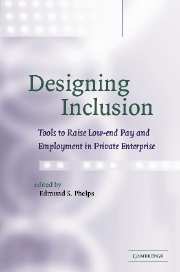Book contents
- Frontmatter
- Contents
- List of figures
- List of tables
- List of contributors
- Introduction
- 1 Low-wage employment subsidies in a labor-turnover model of the “natural rate”
- 2 Taxes, subsidies and equilibrium labor market outcomes
- 3 Learning-by-doing versus on-the-job training: using variation induced by the EITC to distinguish between models of skill formation
- 4 Unemployment vouchers versus low-wage subsidies
- Index
3 - Learning-by-doing versus on-the-job training: using variation induced by the EITC to distinguish between models of skill formation
Published online by Cambridge University Press: 22 September 2009
- Frontmatter
- Contents
- List of figures
- List of tables
- List of contributors
- Introduction
- 1 Low-wage employment subsidies in a labor-turnover model of the “natural rate”
- 2 Taxes, subsidies and equilibrium labor market outcomes
- 3 Learning-by-doing versus on-the-job training: using variation induced by the EITC to distinguish between models of skill formation
- 4 Unemployment vouchers versus low-wage subsidies
- Index
Summary
Introduction
Recent calls for wage subsidies have emphasized their value for attaching low-skill persons to the workplace, attracting them away from lives of idleness or crime (Phelps, 1997; Heckman, Lochner, Smith and Taber, 1997; and Lochner, 1998). Previous empirical research on wage subsidies has focused exclusively on their effects on employment and labor supply. This chapter examines the impact of wage subsidies on skill formation.
By promoting work among those who would not otherwise work, wage subsidies create incentives for workers to invest in skills that are useful in the workplace. The skill formation effects of wage subsidies on persons who would work without the subsidy are more subtle. If skills are acquired as a by-product of work (learning-by-doing), wage subsidies will encourage skill acquisition to the extent that workers increase their labor supply in response to the subsidy. However, if learning is rivalrous with working, as in Becker (1964) or Ben Porath (1967), wage subsidies can discourage investment in skills.
There are even more subtle effects of wage subsidies on skill formation arising from the non-linearity in the return to work created by many proposed schemes.
- Type
- Chapter
- Information
- Designing InclusionTools to Raise Low-end Pay and Employment in Private Enterprise, pp. 74 - 130Publisher: Cambridge University PressPrint publication year: 2003
- 15
- Cited by

